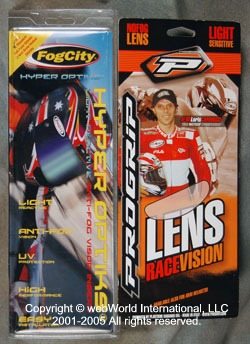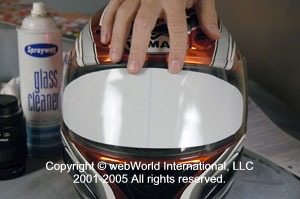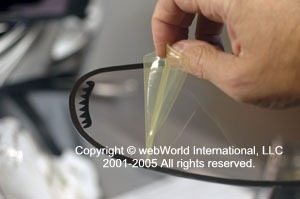Fog City vs. ProGrip Review Review
Anti-fogging properties are excellent, but photochromic ability does not meet expectations.
Our search for the perfect solution to visor fogging has taken us from anti-fog coatings like FogTech and Cat Crap (apparently no longer in business) to visor inserts like Pinlock.
We’ve had a few detours along the way for visor cleaners like Sprayway (review) (which remains our favorite), Plexus (review) and even good ol’ tap water, which is one of the best and certainly the cheapest.
Our journey has taken us through two winter seasons, and we’re about to head into a third, so it’s time to take another look, if you’ll pardon the pun.
The Fog City and ProGrip products are classified as visor inserts, but the terms “visor” and “visor inserts” seem to be interchangeable.
Both visor inserts are primarily designed to prevent visor fogging.
But the versions in this evaluation have an extra feature: they’re photochromic (or “photochromatic”); that is, they are “capable of changing color on exposure to radiant energy”, as defined by the word sages at Merriam Webster.
Are photochromic visor inserts an indicator that photochromic helmet visors will be here someday soon? The answer is maybe, but progress is not coming as fast as one would imagine. Perhaps the technology is at its current limits?
I remember learning about the first experiments with photochromic visors a few years ago.
Several very excited visitors sent us emails about what was then assumed to be the Next Big Thing, and everyone was sure that this would change the world of motorcycle helmets.
After all, wouldn’t it be great to have a visor that changes from clear to dark automatically?
We haven’t heard much about the experiments lately, and our evaluation of the Fog City and ProGrip visor inserts have led us to believe that there may be some technical issues that have been too difficult to resolve, and, in fact, may be impossible to overcome.
The ProGrip visor insert is made by Plastiche Cassano S.r.l. in Italy and is new to the U.S.A. It may be hard to find, but has been available in the U.K. for some time.
Fog City visors have been available for several years and are distributed by Modern World Ventures in California.
There is no country of manufacture listed anywhere on the Fog City packaging, so we’re not sure where the product is made. Isn’t there supposed to be a law regarding country of origin for manufactured products?
Each of these visor inserts are applied on the inside of the helmet visor. This may seem intuitive, but I’ll bet more than one hapless motorcyclist has made the mistake of installing the insert on the outside of the visor.
The directions for both products aren’t entirely clear on this point; so we figured we’d address the issue just for the record.
Each insert has a gasket around its outer edge, and the gasket includes an adhesive coating with a protective vinyl cover over the adhesive that must be removed prior to installation.
Each visor insert also has a thin film that acts as a protective coating over the lens and which also must be removed prior to installation.
The ProGrip visor insert is larger in the top-to-bottom (height) dimension than the Fog City visor. The ProGrip measures 4″ (102 mm) in height compared to the Fog City’s 3-5/8″ (approx. 92 mm). This makes a big difference, as we found.
There just wasn’t enough room in several of the helmets we tried for the ProGrip insert to fit on the inside of the visor without interfering with the visor’s ability to close and seal correctly.
The lesson here is that it’s important to check the dimensions of the inside of the visor, between the top and bottom of the visor opening, to ensure that the ProGrip (or any visor insert, for that matter) will fit before committing to a purchase.
Unfortunately, the dimensions of the inserts are not readily available, which is strange, considering that this can be a make-or-break decision.
Installation
The helmet visor must be clean before the insert can be installed. Each manufacturer suggests a particular cleaning method to ensure the best adhesion, so our best advice is to follow the instructions. Don’t forget that any fingerprints or dirt may end up trapped between the visor and the insert if the visor is not perfectly clean prior to installation.
Before the insert can be installed, the correct location on the visor must be ascertained to ensure that the insert will fit correctly on the inside of the visor without interfering with the visor seal.
Once the correct location is found, the outline of the insert is marked on the outside of the visor for use as a guide when the insert is applied to the inside of the visor itself. To install the insert, the visor must be removed from the helmet.
The guide lines are used to line up the insert and the insert is installed by pressing the adhesive backing to the visor.
The ProGrip instructions call for masking tape to be applied to the outside of the visor and used as a guide.
It wasn’t clear to us whether the tape should be applied so that the edges of the tape act as the guide or if the tape should be applied so that guide lines could be drawn on the tape with a pen.
In any case, we didn’t have any masking tape on hand, so we used a semi-permanent felt-tipped pen to mark the outside of the visor. The ProGrip insert has a tan-colored protective backing that we peeled off to use as a template (photo left, below).
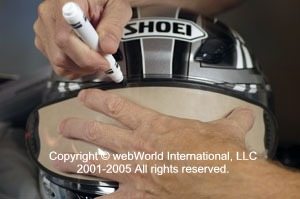
(L) Marking the outside of the visor, using the paper backing from the ProGrip visor insert. (R) The Fog City insert comes with a template that is used to indicate the best position for installation.

The Fog City visor insert comes with a vinyl template in the shape of the insert (photo above, right). The template is designed to cling to the outside of the visor, and it is pre-inscribed with a centerline.
This makes it much easier to lay out the correct location for the insert and helped to make the installation of the Fog City insert easier than the ProGrip.
After the correct location for the insert is determined, the vinyl is peeled from the adhesive gasket. Installing one of these inserts on the back of a visor is somewhat tricky.
The insert must be bent to match the curvature of the inside of the visor, and it’s not easy to get everything lined up to the guide marks.
The instructions recommend that the insert should not be removed after the adhesive touches the visor, so there’s basically only one chance to get it right.
Installation is a matter of trying to get everything lined up correctly and then hoping that the insert will fall correctly into place.
We found that the best procedure seemed to be to start pressing in the middle and work out towards the edges.
It definitely helps to have an assistant hold the visor with two hands and press it down on a towel or soft surface to hold it steady. The towel helps prevent any scratches from occurring on the outside of the visor.
The ProGrip insert was more difficult to install than the Fog City product. The ProGrip insert is almost as big as the visor, and it must be laid out perfectly to get it centered between the top and bottom of the inside of the visor.
We ended up having to remove and replace the ProGrip after installing it and realizing that the visor wouldn’t close properly.
There’s really no reason why the ProGrip insert couldn’t be smaller, because it’s not necessary to have full top-to-bottom visor coverage for these inserts to still get adequate performance.
We couldn’t get either insert lined up perfectly in the horizontal axis, but they are close enough so that the differences are not noticeable at first glance. The instructions recommend not closing the visor for several hours to ensure that the adhesive sets up properly.
This probably is making it sound like the installation is more trouble than it really is.
With a minimal amount of care, either visor insert is easy to install; just make sure that if you choose the ProGrip that you’re careful about locating it correctly.
Photochromic Properties
Although we have several products that can address the visor fogging issue, we were intrigued by the prospect of having a visor that can turn from light to dark.
But we found that not only are there problems with the photochromic capability of the inserts, both manufacturers have some caveats that, in effect, make these inserts much less practical than they should be.
The Fog City visor insert claims that it turns from light green to cobalt blue in 4 seconds, which we found was true, but the manufacturer also warns against using the the visor at night.
Our feeling is that this is a major caveat — after all, the insert is semi-permanent, and one of the main reasons for installing a photochromic visor insert is to take advantage of its ability to darken, eliminating the need to carry an extra visor.
The manufacturers of the ProGrip insert state that the ProGrip “is not appropriate for use on roads that go in and out of tunnels”, which also seems strange and rather defeats the purpose of having photochromic ability.
The instructions also state that the ProGrip visor insert should be replaced annually, while the Fog City has no information on how long the insert will last.
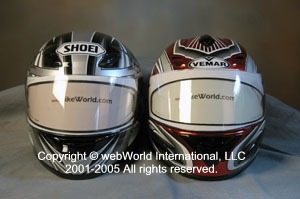
Each insert has a slight tint before it is exposed to sunlight. This photo (left) illustrates the color differences; the ProGrip on the Shoei RF-1000 on the left has a slight gray tint and the Fog City insert on the Vemar VSR on the right has a greenish tint.
To evaluate the photochromic ability of the visors, we first inserted some white paper in back of the visor so that the visor insert colors and darkness would be more visible.
The helmets were placed outside, side-by-side facing south on a stand and covered with dark helmet bags.
The temperature was 89 degrees Fahrenheit (31.6 Celsius) and the sun was shining directly on the helmets.
After the camera was turned on and set, an assistant removed the helmet bags and we took 4 photographs at 2.5 second intervals.
As you can see from the animated .gif photo at the top of this page, the difference in light to dark tint is very minimal, and in fact, we noticed no change whatsoever in the color of the ProGrip insert.
Another set of “before/after” photos below illustrates the base color of the visor inserts at 0 seconds (left) and after 10 seconds (right).
The differences are minimal, and there is also very little apparent difference in light attenuation when wearing the helmets whilst riding.
Our opinion is that the photochromic features on either of these visor inserts does not meet expectations. In addition, the inserts blur the rider’s vision to a certain extent. Our Fog City visor has noticeable blurring and is annoying.
The ProGrip insert seems to have much less blurring than the Fog City product, but some blurring is still noticeable.
Anti-Fog Properties
Although the weather has been too warm here lately to fully evaluate the ability of these products to prevent fogging, both have passed the “steam test”; that is, both of these inserts remained clear when exposed to steam from boiling water.
In this regard, the products are very similar in performance to the excellent anti-fog properties of the Pinlock visor system, and we wouldn’t be surprised to learn if the same company either developed or manufactures all three.


Conclusion
Although both the Fog City and ProGrip visor inserts work to prevent visor fogging, the photochromic capability of each is suspect.
Many of the visors now supplied with motorcycle helmets come with an anti-fog coating, so the added expense and problems associated with installing an additional visor insert may not be worthwhile.
However, for those who live in extreme climates where visor fogging is a problem, these products may be necessary.
Our opinion is that these inserts should not be purchased for their photochromic properties, which does not seem to work as claimed, at least to our understanding of the claims.
| wBW Review: Fog City Hyper Optiks vs. ProGrip Visor Inserts | |
|---|---|
| Manufacturer: Fog City. ProGrip: ? | List Price (2005): $32.95 (Fog City) $25.00 (ProGrip) |
| Colors: Varied | Made In: Unknown |
| Review Date: September 2005 | |
Owner Comments and Feedback
See details on submitting comments.
From “M.A.” (April 2013): “Pinlock developed and markets adhesive fog resistant inserts under the brand name of Fine Vision in Europe.
In 2008 they bought the FogCity brand name to market their Fine Vision inserts in the USA. So there will be some confusion when consumers look at your prior test of FogCity products.
Modern World Ventures, the original owners of FogCity, is now Mari Performance and is selling their improved anti-fog inserts under the Invision brand name.
The Invision visor inserts are now 20 mil polycarbonate as versus 7 mil PET plastic or cellulose acetate.”
From “PDK” (April 2010): “Regarding the Editor’s Note (“Editor’s Note: Some tissue papers and paper towels can be abrasive and are not usually recommended for cleaning any type of clear plastic…”).
I would remove the word “Some”. The pulp in paper is as hard as wood. They feel soft to us, because they are pliable, but they are always abrasive. Carrying a lint-free cloth to use instead fixes the problem.:
From “J.”: “Based on the reviews and others I decided to give Fog City a try. I am very surprised at how well it works. I went outside for a test in 40 degree weather and breathed with my mouth and there was no fogging at all.
The only issue I get is rarely if I’m at a stoplight for more than 5 minutes the visor starts looking glassy where the view is somewhat distorted but it’s MUCH better than seeing nothing through fogged up visors!
I’ve tried rubbing compounds on the visor and my main gripe with them is you have to keep reapplying them! I’ve been a car owner for more than 10 years and transitioning to the bike world is a little challenging mainly the preparing to ride routine.
One thing I miss about the car world is that I just start the car and go. Now with the bike I gotta put on boots, pants, jackets, gloves, helmet, etc.
With Fog City I believe it’s worth the money in the time you save in reapplying another damn coat of anti fog material on the visor!
But I do have to agree that the product is not exactly rock tough and you have to be real careful of not scratching it. What I do is if there’s dirt on the Fog City is to run mildly warm water on it and lightly rub my fingers on it.
Haven’t had any problems with it and I would recommend it to anyone tired of the ol’ “rub anti-fog material every morning” routine!”
From “H.K.”: “Just want to give you some feedback on the ‘reliability’ of the product. I have purchased 3 inserts (3 separate times) for 3 of my many helmets.
First off, I have noticed the shading level is a bit different (can’t quantify, but noticeable) out of the box for these inserts.
Secondly, one of the shields (installed about 9 months ago but since I have so many helmets I may have used it for 15 times or so) doesn’t go too dark (comparing to my one that is working correctly) right out of the box.
Thirdly, my newest one, less than 3 month old and used about 10 to 15 times during ‘less hot’ weather(less than 80degF)has stopped working, meaning it stays at the lightest shade no matter how strong the sun is.
My only one that seems to be working still is probably the oldest one, about 2.5 years old.
Also, at night, all three inserts form halos around cars’ headlights. I have read some reviews on several motorcycle forums and some of the reviews are inline with my finding here.”
From “C.B.”: “I’m a longtime fan of WebBikeWorld, and I want you to know the info you provide is valuable to us out here.
I do want to make a point about the un-tinted, non-photochromatic version of the Fog City ProShield anti-fog visor insert.
While it’s true it never fogs, it’s also true that the soft gum-like anti-fog material facing the interior will scratch when cleaned with a water-dampened Kleenex! I bought two.
They installed easily, and worked well for a couple of weeks. On my second 300-mile weekend with a ProShield-equipped helmet, I sneezed. One shot with a water-dampened Kleenex and the anti-fog surface was scratched beyond usefulness.
The product comes with Maintenance instructions that state “Clean residue buildup with household glass cleaner as necessary. Do not use use cleaners with abrasives or caustics.”
My personal review: Anti-fog qualities: 5 stars; Usefulness/Value/Durability: Zero! I’d never buy one again.
The warranty offers a 90-day replacement. I’ll let the manufacturer know of my experience, but don’t see the point of replacement.”
Editor’s Note: Some tissue papers and paper towels can be abrasive and are not usually recommended for cleaning any type of clear plastic. We have found that the best way to clean a visor is to run it under lukewarm tap water while loosening the dirt with fingers.
Although this may be impractical during a trip, so we usually carry a bottle of water for this purpose.
From “R.S.”: “I have used the ProGrip insert on my Shoei RF900 helmet and found, as advised in the documentation that came with the insert, that the Shoei visor blocks most of the ultra-violet light that is responsible for the photochromic properties.
This may explain why the ProGrip that you tested on the Shoei helmet did not perform as expected.
I also found that the extra height of the ProGrip insert affected the fit of the visor and made it difficult to open and close.
It did, however, perform its anti fog function adequately, but it only lasted about twelve months before it needed to be removed to clean the inside surface. It was impossible to re-install it.”
Editor’s Reply: Thanks for the tip, we hadn’t considered that a UV-blocking helmet visor might affect the photochromic properties.


